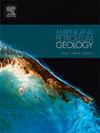Chronology and geofluids characteristics of calcite cement in the Upper Triassic Xujiahe Formation tight sandstone reservoir, Wstern Sichuan Basin, SW China
IF 3.7
2区 地球科学
Q1 GEOSCIENCES, MULTIDISCIPLINARY
引用次数: 0
Abstract
Geological fluid activities significantly influence diagenesis and hydrocarbon accumulations in reservoir rocks. However, it remains challenging to precisely determine the timing of these activities. This study aims to investigate the chronology and geofluids characteristics of calcite cement that leads to reservoir tightness in the Upper Triassic Xujiahe Formation in the Western Sichuan Foreland Basin, which is a critical exploration target for hydrocarbon resources. We examine calcite cement as a marker of fluid activities, employing petrological analyses, U-Pb dating, and in-situ carbon-oxygen isotope analysis. These methods are integrated with simulations of regional burial and thermal histories to assess pore evolution and hydrocarbon accumulation mechanisms in these tight sandstone reservoirs. Results reveal two main calcite cementation stages within the second member of the Xujiahe Formation (Xu-2 Member): early cements from the Middle Jurassic around 175 ± 11 Ma and late cements from the Late Jurassic between 161 and 156 Ma. Initially, basin-derived alkaline fluids and near-surface atmospheric freshwater supplied the calcium and carbon for early cements during ongoing basin subsidence. Calcium and carbon for the late calcite cements came from the dissolution of carbonate rock fragments by organic acids. The heavier δ13C is primarily associated with in-situ generation and consumption of carbon within the system, while the δ18Ofluid, which is close to modern seawater values, is mainly related to active water-rock reactions induced by processes such as the dissolution of carbonate rock fragments by organic acids. The closed diagenetic system due to calcite cementation in the Late Jurassic led to reservoir tightening. Therefore, basin-scale chronological constraints on calcite cement are of great significance for quantitatively studying sandstone reservoir densification and exploring the mechanism and control factors of hydrocarbon accumulation.
中国西南部四川盆地上三叠统徐家河组致密砂岩储层中方解石胶结物的年代学和地质流体特征
地质流体活动对储层岩石中的成岩作用和碳氢化合物的积累有着重要影响。然而,精确确定这些活动的时间仍然具有挑战性。本研究旨在研究四川西部前陆盆地上三叠统徐家河地层中导致储层致密性的方解石胶结物的年代学和地质流体特征,该地层是油气资源的重要勘探目标。我们采用岩石学分析、铀-铅年代测定和原位碳氧同位素分析,研究了作为流体活动标志的方解石胶结物。这些方法与区域埋藏和热历史模拟相结合,评估了这些致密砂岩储层的孔隙演化和碳氢化合物累积机制。研究结果显示,徐家河地层第二层(徐二层)有两个主要的方解石胶结阶段:中侏罗世的早期胶结(175±11Ma)和晚侏罗世的晚期胶结(161-156Ma)。最初,在盆地不断下沉的过程中,盆地源碱性流体和近地表大气淡水为早期水泥土提供了钙和碳。晚期方解石水泥的钙和碳来自有机酸对碳酸盐岩碎片的溶解。较重的δ13C主要与系统内碳的原位生成和消耗有关,而接近现代海水值的δ18流体主要与有机酸溶解碳酸盐岩碎片等过程引起的活跃的水岩反应有关。晚侏罗世方解石胶结造成的封闭成岩体系导致了储层的致密化。因此,盆地尺度的方解石胶结年代学约束对于定量研究砂岩储层致密化、探索油气聚集机理和控制因素具有重要意义。
本文章由计算机程序翻译,如有差异,请以英文原文为准。
求助全文
约1分钟内获得全文
求助全文
来源期刊

Marine and Petroleum Geology
地学-地球科学综合
CiteScore
8.80
自引率
14.30%
发文量
475
审稿时长
63 days
期刊介绍:
Marine and Petroleum Geology is the pre-eminent international forum for the exchange of multidisciplinary concepts, interpretations and techniques for all concerned with marine and petroleum geology in industry, government and academia. Rapid bimonthly publication allows early communications of papers or short communications to the geoscience community.
Marine and Petroleum Geology is essential reading for geologists, geophysicists and explorationists in industry, government and academia working in the following areas: marine geology; basin analysis and evaluation; organic geochemistry; reserve/resource estimation; seismic stratigraphy; thermal models of basic evolution; sedimentary geology; continental margins; geophysical interpretation; structural geology/tectonics; formation evaluation techniques; well logging.
 求助内容:
求助内容: 应助结果提醒方式:
应助结果提醒方式:


